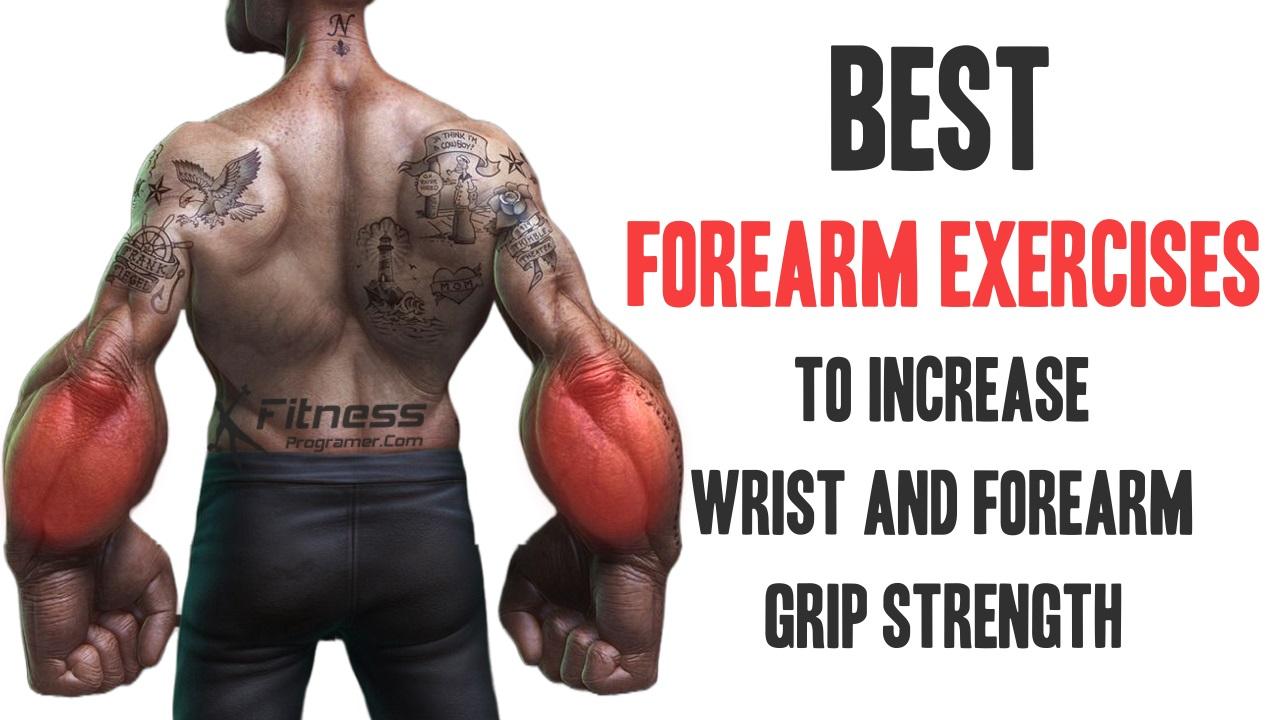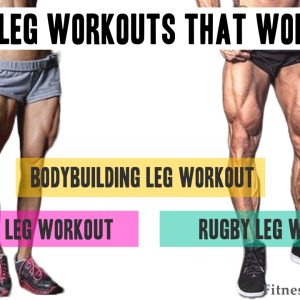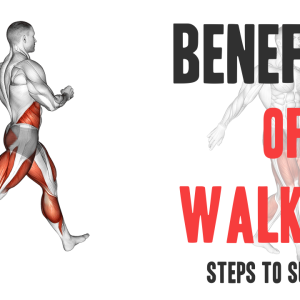Contents
If you really want to increase your upper body strength, try adding some of the best forearm exercises to your workout. And if you play a sport that involves your arms, building up your forearms may improve your performance.
The wrists and forearms are often neglected, but here are some ways to strengthen your forearm and wrist muscles. You can use dumbbells, barbells, cables or any other tool that can add resistance to certain wrist motions.
Wrist strength is important for so many people.
Athletes: If your sport uses a ball or racket/ stick of any kind, having strong wrists can improve your performance and decrease your risk of injury.
Computer Users: If you’re not an athlete, wrist exercises are still important. With computers being so prevalent finger, hand, and wrist overuse injuries are on the rise, and wrist strengthening might be just the thing to help offset some of those injuries.
Bodybuilders: For bodybuilders and power lifters, strong wrists and improved grip strength can sky rocket back strength and lead to a greater ability to build muscle.
Strong wrist muscles can improve performance in sports and daily activities, but the forearms are neglected in most fitness programs. The forearm muscles (wrist muscles) are important for grip strength, and strong forearms can help to improve overall upper body strength. This page gives a brief overview of the anatomy of the forearm.
Anatomy of the Forearm Muscles
The forearm is divided anatomically into the anterior (front) compartment and the posterior (back) compartment. Below, I use the technical names mixed in with more understandable terms. But many muscles are named after the motions they do. Hope that helps to makes it easier to understand the forearm and wrist muscles.
The muscles on the front of the forearm are the flexor group, and they bend the fingers and wrist.
The muscles on the back of the forearm are the extensor group, and they straighten the fingers and extend the wrist.
Some muscles in the forearm go down to the wrist bones and move and stabilize the wrist. Other muscles in the forearm go all the way down to the fingers to move and stabilize the fingers.
Anytime you hold onto any object, your forearm muscles will work together to grip and stabilize the wrist.
Forearm Anatomy: Anterior Forearm Muscles
The muscles on the anterior forearm play a role in bending the wrist and fingers, and forming a fist.
There are 8 muscles in the front of the forearm, and the front of the forearm is sub-divided into 3 layers the superficial, intermediate, and deep layers. (1)
The superficial layer of the anterior forearm contains 5 muscles:
- Pronator teres
- Flexor carpi radialis
- Palmaris longus
- Flexor carpi ulnaris.
- Flexor Digitorum Superficialis
The pronator teres turns the palms down and assist at bending the elbow, and the other three muscles in the superficial layer bend the wrist (flex the wrist).
What is unique about the superficial layer is that they all start on a common tendon on the inside part of the humerus (the medial epicondyle)– the big bone that sticks out on the inside part of the elbow joint.
Overuse/ tendonitis of these muscles is often referred to as “Golfers Elbow” or medial epicondylitis.
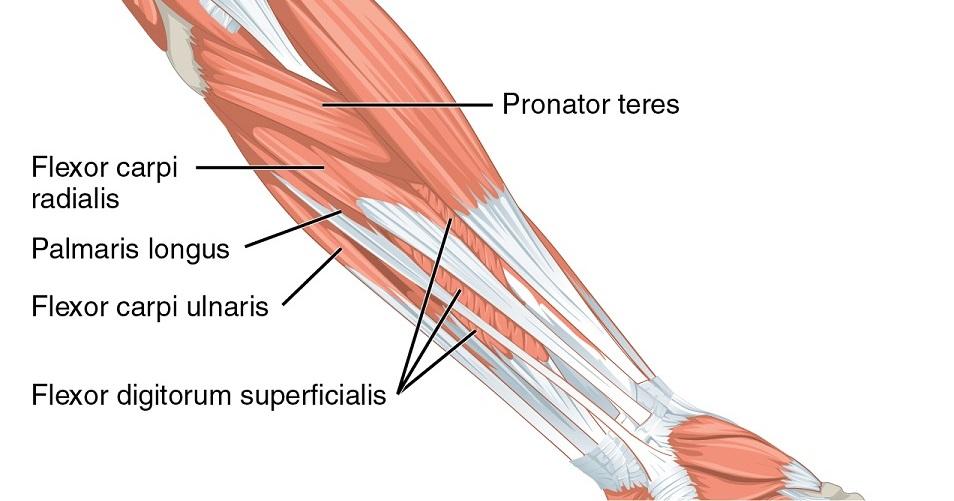
The intermediate layer contains only one muscle, the flexor digitorum superficialis, but this muscle is large and goes to all 4 of the fingers.
The name says what it does. It is the superficial muscle that flexes (bends) the fingers. It obviously helps with grip strength.
The deep layer of the anterior forearm contains 3 muscles:
- Flexor digitorum profundus
- Flexor pollicis longus
- Pronator quadratus
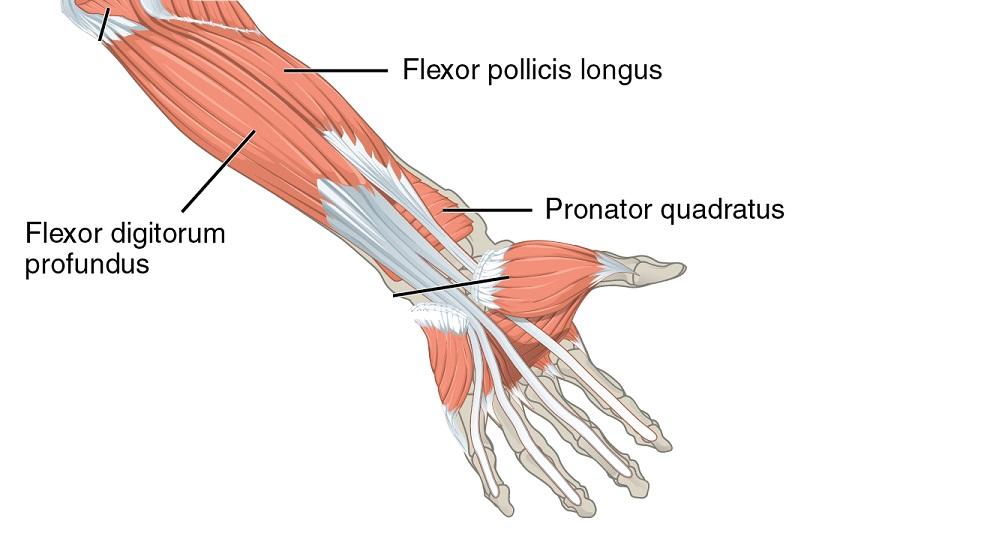
The flexor digitorm profundus works with the superficialis to bend the fingers.
Pollicis refers to the thumb, so this muscle helps to bend the thumb, and the pronator quadratus helps to turn the palms down (pronation of the forearm).
Forearm Anatomy: Posterior Forearm Muscles
The muscles in the posterior forearm work to extend or straighten the wrist and fingers.
There are 12 muscles on the back of the forearm, and they are sub-divided in 2 layers: superficial and deep. (2)
The superficial layer contains 7 muscles:
- Brachioradialis
- Extensor carpi radialis longus
- Extensor carpi radialis brevis
- Extensor digitorum
- Extensor digiti minimi
- Extensor carpi ulnaris
- Anconeus.
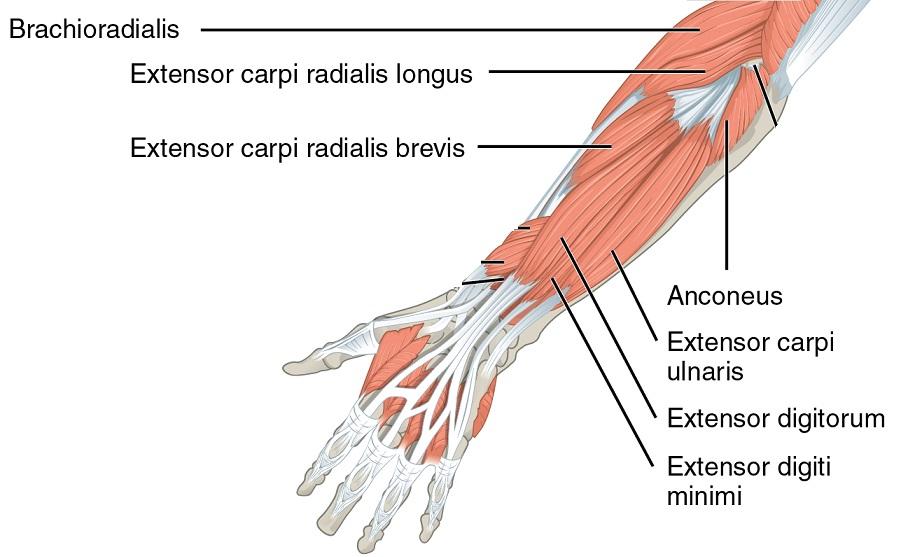
The brachioradialis is the “hand shake muscle”. It actually bends your elbow when your arm is in the position to shake someone’s hand. And it works hard during exercises like hammer curls.
The other muscles in the superficial layer play a role in straightening/ extending the wrist and stabilizing the wrist.
Similarly to the anterior compartment, many of the muscles in the posterior compartment attach to a common tendon on the outside of the elbow (the lateral epicondyle).
Overuse and tendinitis at the lateral epicondyle is referred to as “Tennis Elbow” or lateral epicondylitis.
The deep layer contains 5 muscles:
- Supinator
- Abductor pollicis longus
- Extensor policis brevis
- Extensor pollicis longus
- Extensor indicis.
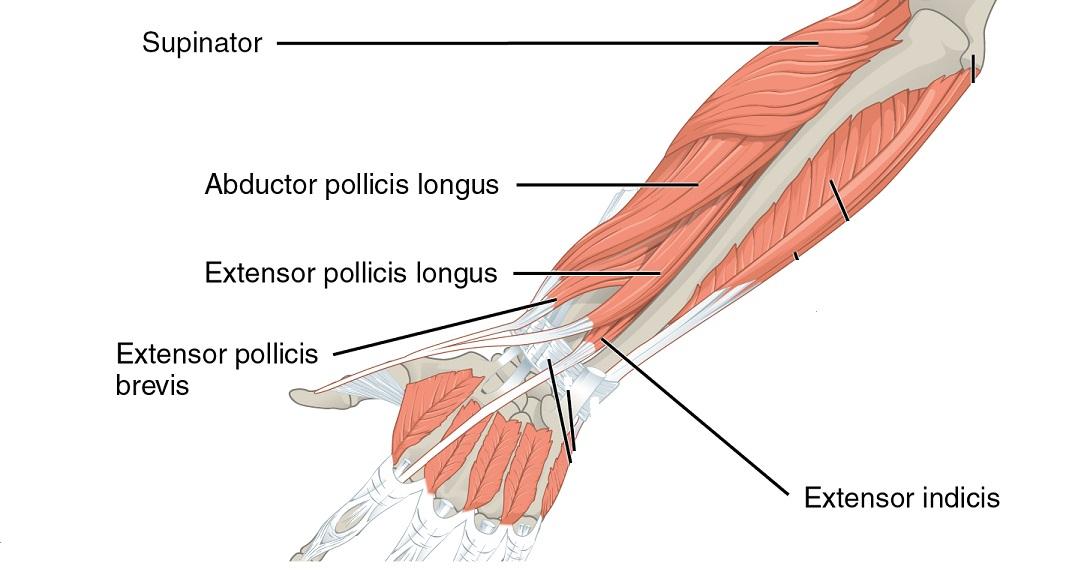
The supinator turns the palms face up.
Pollic refers to the thumb. The Abductor pulls the thumb out to the side and the extensors pull the thumb backwards.
Indicis refers to the index finger, and this muscle pulls the index finger backwards.
Conclusion:
Don’t be so worried about remembering all the names of all the forearm muscles.
Just think the muscles on the front of the forearm bend the wrist and fingers, and the muscles on the back of the forearm straighten the wrist and fingers.
When you are holding things, both groups of muscles work together to stabilize the fingers and wrists.
How to get bigger and stronger forearms
The wrist moves in 6 main directions: forwards (flexion), backwards (extension), outwards (radial deviation or abduction), inwards (ulnar deviation or adduction), turning up/ palms up (supination), and turning down/ palms down (pronation).
All of the muscles that move the wrist are located in the forearm area, so when you move your wrists you strengthen your wrists and forearms.
The Best Wrist and Forearm Exercises
Here are some of the best forearm exercises for men and women to include in your forearm workouts. These are also great wrist exercises to strengthen weak wrists and hands.
1- Dumbbell Wrist Curls
Seated dumbbell wrist curls are a great wrist exercise.
Wrist curls are a great way to strengthen your wrists and improve your grip strength.
Since the forearm and wrist muscles are relatively small, you don’t have to use heavy weights to really feel your muscles working.
For some people, 1-5 pound dumbbells are heavy enough to get a good workout.
Below are pictures of the seated wrist curls with dumbbells.
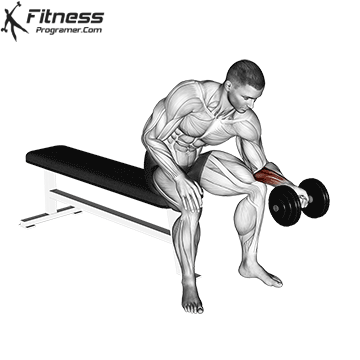
Starting Position: Sit on a bench and rest your forearms on your thighs. While holding the dumbbells, keep your palms facing up towards the ceiling, and allow your wrists to extend towards the floor.
Form: Exhale and curl your wrists up towards the ceiling. Hold for a brief moment at the top and then slowly lower to the starting position.
Personal Trainer Tips: Do your best to use the full range of motion at the wrists. Use your knees as a fulcrum to allow your wrist to extend as far as you can comfortably go.
2- Hand Gripper

The forearms are often neglected in fitness programs, but having strong forearm muscles can really improve other areas of fitness.
So don’t totally neglect forearm and wrist exercises.
This is an easy exercise for the wrists. You can easily do it in between other upper body exercises.
If you’re at a computer all the time, you can benefit from wrist strengthening.
And if you play sports that involve holding a ball, racket, club, bat or anything else wrist strengthening exercises can help you with those sports.
3- Neutral Dumbbell Wrist Curl
Neutral dumbbell wrist curl, sometimes known as radial deviation or hammer grip, works the muscles and tendons around your radius bone and strengthens nearly all the muscles that support the wrist joint.
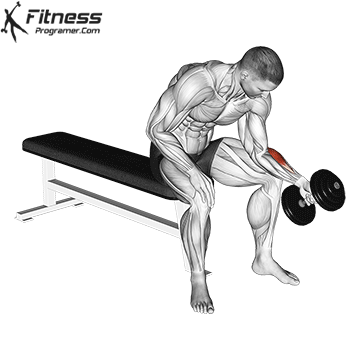
Starting Position: Sit on a bench and rest your forearms on your thighs. Hold the dumbbells as if holding a hammer and let your wrists reach toward the floor.
Form: Exhale and curl your wrists up towards the ceiling. Hold for a brief moment at the top and then slowly lower to the starting position or a few degrees down.
Move in a slow and controlled manner, and stretch your wrists after a tough workout.
4- Behind the Back Barbell Wrist Curls
Behind the back barbell wrist curls are a great wrist and forearm exercise, and it can improve your grip strength.
The wrist moves in many directions, but the main 2 are forwards (flexion) and backwards(extension).
Moving forwards works the front of the forearm and moving backwards works the back of the forearm.
The behind the back wrist curl works the front of the forearm and is great for improving grip strength.

Starting Position: Place a barbell on a rack so that you’ll be able to reach it. Then, grab the barbell behind your back.
Form: Exhale as your curl your wrists up towards the ceiling. Hod for a brief moment and then slowly lower to the starting position.
Personal Trainer Tips: There are slight variations in the width of barbells. A thicker barbell will force your forearm muscles to work harder than a thinner barbell.
Also, wearing lifting gloves will make your wrists and forearms work harder. The wider the surface you have to hold onto the harder your wrist and hand muscles have to work.
You can also do this exercise with dumbbells.
5- Wrist Rolls
Wrist rolls or rolling a rope over a stick is a great way to strengthen the wrists and forearms. No matter your goal this exercise can help.
Note: This is can be a tough exercise, but it really strengthens your wrist muscles and grip strength.
Most people feel a serious burn in the forearms after doing a couple of sets of this exercise, so try stretching out your wrists after you get done with this exercise.
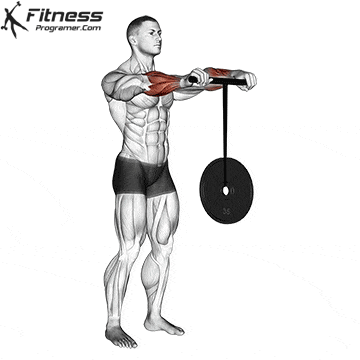
Starting Position: You’ll need a stick with a hole drilled in the middle of it and a rope threaded through the hole.
Attach some weights to one end of the rope, and then hold the stick straight out in front of you with the weights on the floor.
Form: While holding the stick out in front of you, roll your wrists forwards to lift the weights off the floor. Keep going until you get the weights all the way to the top.
Then, roll your wrists backwards to lower the weights back down to the floor.
Personal Trainer Tips: Many gyms have a stick for this purpose, but if not it’s pretty easy to make this for a home gym– all you need is a rope, a stick, and some weights.
Also, note that a thicker stick will challenge your muscles much more than a thinner stick.
6- Pulling and Gripping Exercises for the Forearms
In addition, to exercises that move the wrist, any exercise that requires you to grip or hold on to weights will strengthen your grip strength and forearm muscles.
Many back exercises, like pull ups, the lat pull down machine, the seated row, dumbbell rows, or the barbell row will increase grip strength.
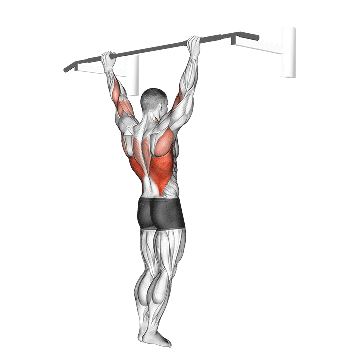
Also, many trapezius exercises, like shrugs or the farmer’s walk will work on grip strength.
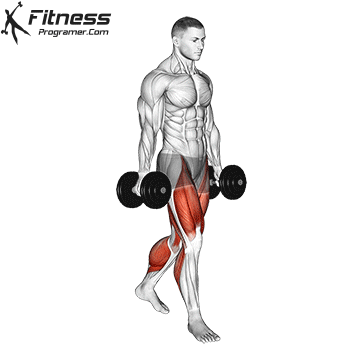
Even leg exercises that use dumbbells (like dumbbell squats, lunges, or dead lifts work on your grip. And, one of the best leg exercises to increase grip strength is the barbell dead lift.
Any time you have to hold onto weights or pull weights you will be working on your forearm muscles and grip strength.

